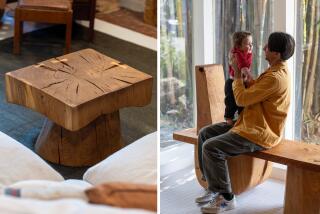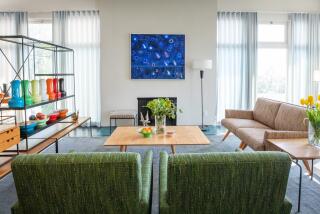Carving Out a Noble Calling
- Share via
Once upon a time in a kingdom faraway, there was a handsome young lord who loved . . . furniture.
He loved smooth blond woods inlaid with ebony, rounded bureaus of luscious Swiss pear, sweet little satinwood tables, and long-legged consoles of sycamore and oak.
He cared not a whit for titles and jewels--only his woodworking and his beloved “Granny.”
Truth is, until he set eyes on California, David, Viscount Linley seemed to have all he needed for happily-ever-aftering, including a beautiful new wife. But earlier this month as he prepared to leave Los Angeles, he found himself in need of a favor.
“If it wouldn’t be too much trouble,” Linley asked a reporter, “perhaps you could mention that I would very much like to be invited back.”
No royal commands here. So what if Princess Margaret is his mum and the Queen of England is his auntie? David Albert Charles Armstrong-Jones--just “David” to his friends, “Lord” to the rest of us--has manners as exquisite as the furniture he makes.
At 32, Linley could be a ne’er-do-well, a pub-crawler, a gadfly or a playboy. But this member of the royal family--12th in line to the throne--is simply a carpenter.
In the United States to introduce his historical book “Classical Furniture,” Linley wants to return to L.A. (but only if invited) for a full-scale exhibit of his handmade classical designs. Californians, he says, deserve it.
“People here have a great respect for craftsmanship, for quality, for specialness,” he says. “Californians are not so precious about their antiques, not so nervous about what others will think if they mix classic with modern, old with new.”
*
Sitting on a white lawn chair in front of a bubbling fountain at the Hotel Bel-Air, Linley basks in the morning sun. The sun has not stopped shining during his four-day stay. Back in the kingdom, it is gray and cold. “As usual,” Linley hrrrumphs.
According to the catty British tabloids, this shy man with the freckles on his cheeks may well be the House of Windsor’s “last, best hope” for secular success.
Unlike some of his naughty cousins and their even naughtier spouses, Linley has given the royal-bashing British press little to write about. The fact that the viscount is the only member of the royal family to bring a libel suit to court may have something to do with this. (He won about $80,000 from a newspaper that falsely reported that he was tossed out of a London pub for drunken behavior.)
Linley is popular in Britain because he works hard for a living--”six days a week, I’m afraid.” He’s modest. He’s bright. His ears aren’t too big. And, according to such customers as Mick Jagger and the Metropolitan Museum of Art, he appears to have enormous talent as a craftsman.
For the New York museum, he designed and built a 60-foot, 88-legged table. He won’t specify what he built for Jagger, Blaine Trump or other celebrities because “it’s not my place.”
Nevertheless, the opening plate in his 192-page coffee table book features one very grand celebrity consignment: the elegant sycamore cabinet he designed to hold 250 pairs of Elton John’s eyeglasses.
Gentleman that he is, Linley does not disclose what the singer paid, nor will he discuss costs of other custom-ordered pieces. But, according to price lists at the David Linley Furniture company on London’s fashionable Pimlico Road, pieces from his collection range from handcrafted candleholders for about $40 to massive pieces of furniture for tens of thousands of dollars.
*
From an early age, Linley was crafting special pieces for his relatives, who, in this case, were significant patrons. At the age of 13, he completed his first desk. Elizabeth, the Queen Mother, an avid art collector, has been a lifelong source of inspiration and support, and she owns a variety of Linley wood sculptures, candleholders and fruit bowls, he says.
“When I would visit my Granny as a little boy, we would play this game of closing our eyes and describing everything around us. The color of a tie. The shade of a cloth. It was really quite a wonderful way to learn how to look, to notice things and to appreciate what is around you,” Linley says.
The other great influence on Linley’s art--and art is how many critics view his custom furnishings--has been his father, world-famous photographer Anthony Armstrong-Jones, Earl of Snowdon.
“As children, we essentially had no toys. When we would ask for some, my father would suggest we make our own. And together, we did,” Linley says. “I believe I inherited my love of gadgets and little things that work from my father.”
Encouraged by both parents to make his own way in the world, Linley receives no money from the Civil List. When he married heiress Serena Stanhope on Oct. 8, the bride and groom asked their 150 guests to contribute $50 each toward the post-reception supper.
The couple will take up residence in the three-room London flat Linley has lived in since his graduation from the John Makepeace School for Craftsmen in Wood.
“I love wood. I love its permanence, its way of changing hue over the years, its way of expanding and contracting, of moving or aging and growing better and more beautiful with time,” says Linley, who once rescued a fallen oak tree from the grounds of Windsor Castle to make a front door for his apartment.
Among the artfully organized clutter in the “still-evolving” apartment are many pieces of wood art and other art, including paintings and drawings by his cousin Prince Charles. On a small easel there is a treasured snapshot of the Queen Mother smiling in the front seat of Linley’s convertible.
The grandest piece of furniture in the flat is an unassuming oak table that Linley built for his kitchen. Like most of his furniture, this piece has no finish, only the rich dark luster that comes from coat after coat of hand-applied polish and oils.
The table also has an interesting set of names carved into its smooth top.
“My father was the first to carve his name. And then later, some others carved their names as well. I rather like the look of it. I really do build furniture to be used, you see, to be lived with.”


